Multispektraltechnik
Die Multispektraltechnik weist gegenüber der herkömmlichen RGB-Aufnahmetechnik eine wesentlich höhere Farbtreue auf: Eine erhöhte Anzahl von Farbkanälen wird verwendet, die den sichtbaren Wellenlängenbereich feiner abtasten, und so kann das aufgenommene Spektrum geschätzt werden. Farbaufnahmen mit RGB-Kameras enthalten hingegen einen systematischen Farbfehler, da es keine einfache lineare Abhängigkeit zwischen der spektralen Empfindlichkeit einer RGB-Kamera (siehe Abb. 1) und der eines menschlichen Beobachters.
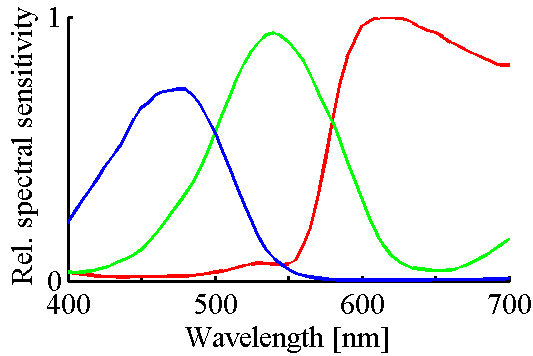 |
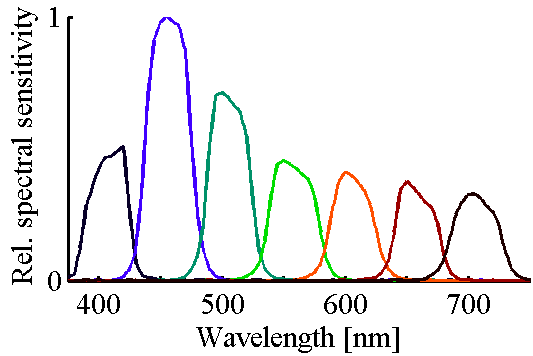 |
| Abb. 1: Spektrale Empfindlichkeit der 3 Farbkanäle einer RGB-Kamera | Abb. 2: Spektrale Empfindlichkeit unserer 7-kanäligen Multispektralkamera |
Multispektralkameras finden damit Einsatz in farbkritischen Applikationen wie der Aufnahme von Kunstgemälden, der Druckvorstufe, der industriellen Qualitätskontrolle, der Fernerkundung, sowie der Medizin, wo beispielsweise die spektrale Zusammensetzung von biologischem Gewebe zur Krebsdiagnose ausgewertet oder die Funktionsweise von Zellen analysiert.
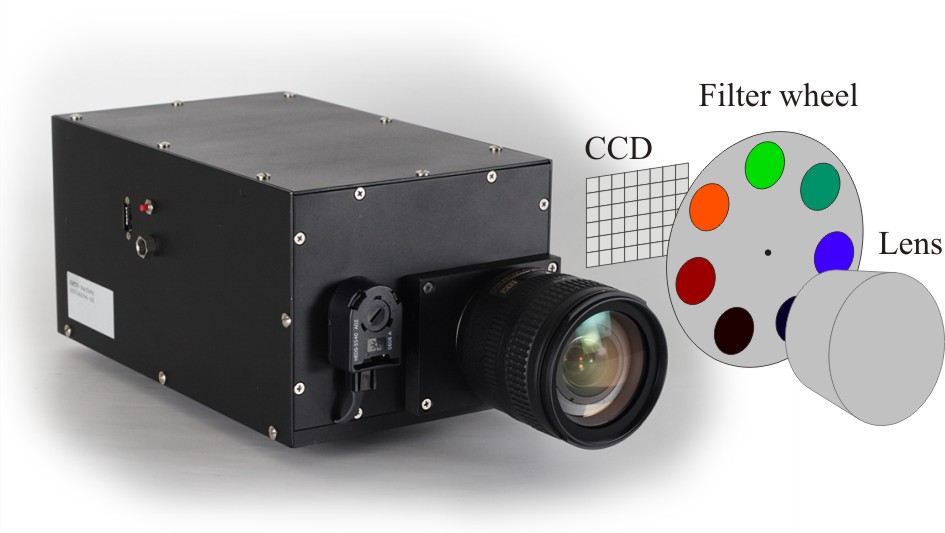
Ein weit verbreiteter und hochwertig aufzeichnender Kameratyp für multispektrale Aufnahmen nutzt einen monochromen Sensor und optische Bandpassfilter, die sich üblicherweise in einem Filterrad befinden. Am Lehrstuhl für Bildgebung und Bildverarbeitung werden solche Multispektralkameras benutzt (siehe auch unsere Ausstattung), die entweder 7 oder 19 Farbfilter beinhalten. Das Beispiel der Empfindlichkeit der 7-kanaligen Multispektralkamera ist in Abb. 2 zu sehen. Das Filterrad ist dabei zwischen dem Sensor und dem Objektiv angeordnet, siehe Abb. 3. Somit besteht die Aufnahme eines Multispektralbilds aus 7 oder 19 Bildern (auch Farbkanälen genannt), die sukzessiv erfasst werden. Das Spektrum wird durch die Farbkanäle abgetastet und kann wieder rekonstruiert werden.
Geometrische Kalibration und Kompensation von Multispektralkameras
Wegen der Farbfilter, die sich im Filterrad befinden, werden die Strahlen bei jedem Farbkanal anders gebrochen und es treten in solchen Filterradkameras Aberrationen auf. Sie wurden gründlich im Projekt „Geometrische Kalibration und Kompensation von Multispektralkameras“ analysiert, das von der Deutschen Forschungsgemeinschaft (DFG) 2009 bis 2012 gefördert wurde.
Weiterhin wurde in diesem Projekt die Erfassung von Stereoaufnahmen mit Multispektralkameras untersucht, die aus RGB-Kameras und Farbfilter bestehen. Mehr Informationen über das Projekt befinden sich hier.
Multispektrale goniometrische Aufnahmen
In geplanten Arbeiten sollen nun die erarbeiteten Algorithmen und Verfahren weiter verfeinert und auf komplexere Materialien und Objekten angewendet werden, deren spektrale Eigenschaften eine starke Winkelabhängigkeit aufweist. Solche Materialien erfordern eine goniometrische Messung, d.h., eine Messung aus verschiedenen Aufnahmewinkeln und mit verschiedenen Beleuchtungswinkeln.
Unser Messstand ermöglicht eine Messung wo die Senkrechte zur Objektoberfläche, das Messgerät und die Beleuchtung sich in einer Ebene befinden (in-plane Messung). Als Messgerät können sowohl ein Spektralradiometer, das die Remissionsspektren für eine kleine Fläche des Objekts misst, als auch eine Multispektralkamera benutzt werden. Für eine bessere spektrale Auflösung wird dabei die 19-kanalige Multispektralkamera verwendet. Ein Beispiel einer goniometrischen Multispektralaufnahme ist in Abb. 4 dargestellt. Es handelt sich dabei um einen Effektlack, der mit dem Beleuchtungswinkel +45° aus verschiedenen Positionen erfasst wurde. Die Winkelabhängigkeit dieses Materials ist sehr deutlich zu sehen.
Abb. 4: Multispektrale Aufnahmen eines Effektlacks für verschiedene Aufnahmewinkel
Kontakt
Veröffentlichungen (Auswahl)
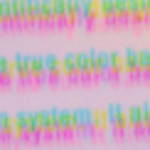 |
Zusammenfassung unserer Forschung im Bereich der Multispektraltechnik, im Rahmen der “Special Session in Memory of Til Aach”: Julie Klein Multispectral imaging and image processing In: IS&T/SPIE Electronic Imaging: Image Processing: Algorithms and Systems XII San Francisco, California, USA, February 2014 |
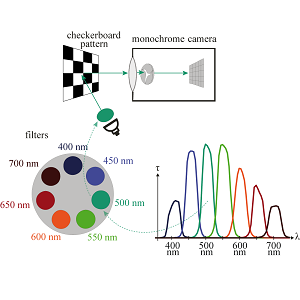 |
Julie Klein, Johannes Brauers and Til Aach Spatio-spectral modeling and compensation of transversal chromatic aberrations in multispectral imaging In: Journal of Imaging Science and Technology, vol. 55 (6), 060502, December 2011 |
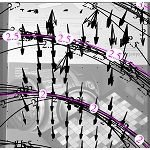 |
Julie Klein and Georg Schmücking Analysis of aberrations and pixel information in goniometric multispectral imaging In: IS&T/SPIE Electronic Imaging: Measuring, Modeling, and Reproducing Material Appearance San Francisco, California, USA, February 2014 |
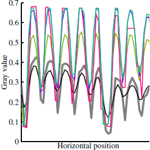 |
Julie Klein Correction of longitudinal aberrations in goniometric measurement with a multispectral camera In: 19. Workshop Farbbildverarbeitung, p. 31-41 Ilmenau, Germany, October 2013 |
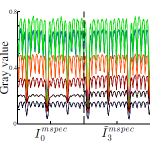 |
Julie Klein Unsupervised correction of relative longitudinal aberrations for multispectral imaging using a multiresolution approach In: IS&T/SPIE Electronic Imaging: Color Imaging XVIII San Francisco, California, USA, February 2013 |
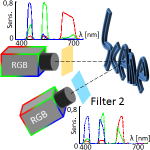 |
Julie Klein and Bernhard Hill Multispectral stereo acquisition using two RGB cameras and color filters: color and disparity accuracy In: 18. Workshop Farbbildverarbeitung, p. 89-96 Darmstadt, Germany, September 2012 |
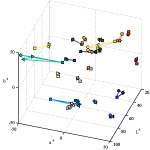 |
Julie Klein and Til Aach Spectral and colorimetric constancy and accuracy of multispectral stereo systems In: IS&T Sixth European Conference on Color in Graphics, Imaging and Vision (CGIV 2012), p. 239-246 Amsterdam, Netherlands, May 2012 |
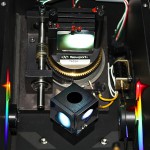 |
Julie Klein, Johannes Brauers and Til Aach Spektrale Charakterisierung einer Multispektralkamera In: 16. Workshop Farbbildverarbeitung, p. 18-27 Ilmenau, Germany, October 2010 Presentation |
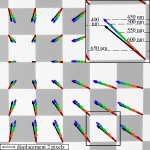 |
Julie Klein, Johannes Brauers and Til Aach Spatial and spectral analysis and modeling of transversal chromatic aberrations and their compensation In: IS&T Fifth European Conference on Color in Graphics, Imaging and Vision (CGIV 2010) 12th International Symposium on Multispectral Colour science, p. 516-522 Joensuu, Finland, June 2010 Presentation |
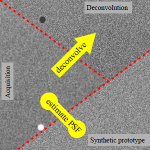 |
Johannes Brauers and Til Aach Direct PSF estimation using a random noise target In: IS&T/SPIE Electronic Imaging: Digital Photography VI, p. 75370B-1 – 75370B-10 San Jose, USA, January 2010 |
Letzte Aktualisierung: 2. Januar 2014


